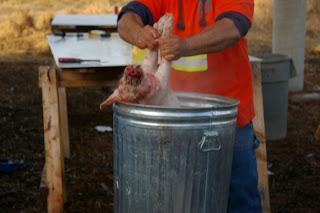I've been selling an increasing number of my animals live, to people who want to prepare them themselves. Each culture has its own traditions and preferences, and each one its favorite food.
Soni and Sime have been great customers of mine. They prefer a small pig, what I call a weaner pig, usually having a live weight of 40 to 50lbs.
I'm ok with people eating animals; I eat them myself, and that's why I started farming -- to make sure the animals I eat have the best life possible while there here.
For pigs, I prefer they be shot. It's a clean and quick, humane end. There are many cultures that have a specific way they kill the pig, and while I try to be tolerant of other cultures, I've found that a bullet is the way that I prefer, and for animals killed on my farm that's what I require.
After shooting, the next step is to cut the arteries at the top of the heart while it's still beating. Most of the blood is out of the pig in a few seconds. After that, it looks like this.
 Pork skin is delicious.
Pork skin is delicious.Pork rind (southern USA) or pork scratchings (UK) or Pork crackle (Australia) or in spanish They will be spit-roasting these pigs whole. The skin of the pig is a prized bit -- it's delicious. In the south part of the USA, they'll call it pork cracklins or pork rind. In Spanish it's chicharrones. Whatever language, many cultures all over the world love it, and Tongans are no exceptions.

All pigs end up white after they've been scraped, no matter what color they started with. This particular animal had a moire pattern on its skin. The line there is where the outer layer of skin has been removed. These fellows dip the pig, and then pull it out and lay it down, and rub off the skin with their fingers. the fellow on the left is removing the toenails from the pig. they don't cut the feet off -- the whole pig is spit-roasted.

The head is a favorite part of the roasted pig, but there's a lot of hair on the head. It takes a while to scrape it all off. There are a lot of nooks and crannies that have to be cleaned.

 The torch quicky removes the hair. They run the torch over one side, flip the pig, and finish the other side. They are very careful to get every single hair.
The torch quicky removes the hair. They run the torch over one side, flip the pig, and finish the other side. They are very careful to get every single hair.
Now you carefully cut around the anus. The goal here is to cut the anus free, but not to cut the colon it is attached to. He makes a small square cut around the anus and poking his finger in carefully works it free, cutting as he goes.
 The digestive system is pretty much free, but the opening at the anus isn't large enough to allow the liver or other large organs to come out. So an incision is now made in the belly -- but a small incison. They're going to spit-roast the animal, so they want the ribcage to be whole so that it'll be easier to spit.
The digestive system is pretty much free, but the opening at the anus isn't large enough to allow the liver or other large organs to come out. So an incision is now made in the belly -- but a small incison. They're going to spit-roast the animal, so they want the ribcage to be whole so that it'll be easier to spit. Working his hand in carefully, he pulls the colon out the incision, and then the rest of the organs. The heart and lungs and kidneys also come out this same hole.
Working his hand in carefully, he pulls the colon out the incision, and then the rest of the organs. The heart and lungs and kidneys also come out this same hole.
Once the organs are out, they sort through them and cut out the ones they want; in this case, the heart, liver, kidneys and lungs.

 This pig is now ready to go for spit roasting. Soni and Sime -- happy holidays
This pig is now ready to go for spit roasting. Soni and Sime -- happy holidays If you'd like to learn how to roast a pig from here, there's a great website that goes into detail. You'll find it here http://cuban-christmas.com/pigroast.html
If you'd like to learn how to roast a pig from here, there's a great website that goes into detail. You'll find it here http://cuban-christmas.com/pigroast.html





1 comment:
Well written.
I've done this one time myself as I feel the process is an important one.
I would prefer to do this more often with my meat, but circumstances prevent it on a more regular basis.
You have a great farm, and are taking great care of your animals.
Post a Comment